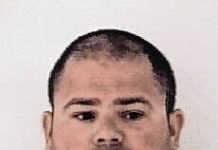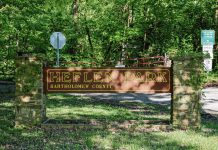Using the architecture of the national Civil Rights Memorial as a reference point, a speaker on tolerance, inclusion and diversity asked local residents to see themselves in an open space in the marble as a part of the ongoing civil rights movement.
Lecia Brooks, outreach director for the Southern Poverty Law Center in Montgomery, Alabama, was the keynote speaker Thursday night at The Commons for the 2018 Human Rights Commission annual dinner meeting.
She began her remarks by showing a photo of the memorial, located in Montgomery and created by Vietnam Veterans Memorial designer Maya Lin. It consists of a circular black granite table that includes the names of civil rights martyrs and chronicles the history of the civil rights movement.
Brooks talked about the significance of the 1954 Brown vs. the Board of Education U.S. Supreme Court ruling, issued 64 years earlier to the day, saying it was “the first time the highest court in the land ruled in favor of black folks and encouraged us we could get things done.”
[sc:text-divider text-divider-title=”Story continues below gallery” ]Click here to purchase photos from this gallery
She then moved to Aug. 28, 1963 and the March on Washington for Justice and Freedom and the speech by Dr. Martin Luther King Jr., delivered in a volatile time in the civil rights movement.
That year also marked the assassinations of President John F. Kennedy and civil rights activist Medgar Evers, and was the year white supremacists blew up a Baptist church in Montgomery, killing four black girls ages 11 to 14.
This turbulent time led to the 1964 Civil Rights Act, which functionally eliminated Jim Crow segregation laws in the South, she said.
Status report
“It’s in peril,” she said of the landmark legislation. “If you dig into what the Civil Rights Act was about, you’ll find out why it’s in peril.”
The legislation didn’t include voting rights but was followed by the 1965 Voting Rights Act, which eliminated various devices, such as literacy tests, that had traditionally been used to restrict voting by black people.
The blank space on the Civil Rights Memorial asks visitors to look down and see themselves in the marble, Brooks said.
“What would be said about you and what you did in your life,” she said. “The good news is there is plenty of time to write that story.”
Brooks then talked about today’s challenges, including showing a scene of swastikas painted on Jewish headstones, and the recent rise of anti-Semitism around the U.S.
“You can choose to not see it, but it’s there,” she said. “Anti-Semitism is on the rise globally. We’re seeing it everywhere.”
She cited a statistic that a third of Americans don’t believe that 6 million Jews were murdered during the Holocaust. And among surveyed millenials in the United States, two thirds could not explain what Auschwitz was.
Auschwitz was one of the largest Nazi concentration and death camps in World War II, which opened in 1940 in southern Poland. Of the 6 million Jews who died in concentration camps during the war, one in six was killed at Auschwitz.
Rise in rhetoric
In addition to anti-Semitism, there is also an ongoing undercurrent of phobia about Islam and Muslims, she said.
“Mosques can’t be built fast enough before they are fire bombed,” she said. “I don’t know that we are really thinking about this. What are you going to do about changing this?” Brooks asked.
Hate crimes against Muslim people in the United States rose 15 percent in 2017, she said.
“I share this not to bring you down, but it’s important that you are aware of this,” she said.
A rise in anti-immigrant rhetoric is another challenge, with a tremendous uptick in complaints about hate crimes, Brooks said. The Southern Poverty Law Center has received as many as 1,000 complaints a month about this type of behavior.
Acknowledging that everyone has an opinion about immigration law, Brooks said it need not include dehumanizing people based on their immigration status.
Roundups by federal immigration agents are continuing in the South, with people being sent off to detention areas to await deportation, often without any legal representation, she said. In 1994, there were 6,000 people in immigration detention compared to 38,000 in 2017.
White supremacy
In addition to these actions, the center is seeing an increase in recruitment of young white males to join white supremacy groups, she said.
“They are out to get your children,” she said of such groups.
“There is a false notion that diversity inclusiveness doesn’t include white folks,” Brooks said. “We — us — need to do a better job to include white people in our multicultural efforts.”
Showing a photo of the Charlottesville, Virginia clash between protestors and white supremacists, Brooks said she wanted to point out that this wasn’t just a few individuals. There were 1,000 young men carrying torches that were a part of this incident.
“This was the boldest act of racial intimidation we’ve seen in decades,” she said. “The torches are meant to remind people of Klan torches. We’ve got to do something about this because we are losing a generation here.”
In Indiana, 31 hate groups have been identified out of 954 nationwide, “which I think is a lot,” Brooks said of groups identifying themselves as Klan, neo-Nazis, White Nationalists, Black Nationalists and the Nation of Islam.
She made particular mention of the Traditionalist Worker Party, which held a practice march in downtown Columbus in September. Brooks said the group’s national leader, Matthew Heimbach of Paoli, Indiana, was in jail — and said the organization is no longer viable.
Action steps
To innoculate the Columbus community from having these groups, Brooks provided a step-by-step guide, advising community residents to act when they see a group or individual being attacked for their race or ethnicity, and to support victims of hate and bias incidents.
She advocated for teaching tolerance throughout the school system and in the community. And if there is some sort of rally advocating hate, she advised creating an alternative event at a different location to advocate inclusiveness — a way of turning the thermostat down and taking away recruiting opportunities for hate groups.
Brooks advocated that each individual dig deeper into their own biases and issues, because it’s not always about other people, she said.
“Sometimes you have to look at your own stuff — where the biases are,” she said. “Look at it and cleanse it. That’s not a bad thing.”
“Warm community”
She praised Columbus for its sense of community and how she was welcomed when she arrived on Thursday.
“You can learn a lot from just talking to people in a community — walking around and meeting people,” she said. “I’ve been in this city not 12 hours yet, and it feels like a community. It’s a nice town. I want you to know you have a warm community — and it’s not like that everywhere in the U.S.”
About 350 people attended the program at The Commons, a gathering large enough to show that residents are focusing on tolerance and inclusion, Brooks said.
The Columbus commission came into being two years before passage of the U.S. Civil Rights Act of 1964, landmark legislation that banned discrimination based on race, color, religion, sex or national origin.
Quoting from the Civil Rights Memorial, Brooks said “We will not be satisified ‘until justice rolls down like waters and righteousness like a mighty stream,’ ” King’s words from the March on Washington.
“So I ask you to think about this in the same way,” she said. “Do more. Do better. You’re doing great but you can do better.”
[sc:pullout-title pullout-title=”J. Irwin Miller Art and Benjamin M. King Essay contest winners” ][sc:pullout-text-begin]
The Columbus Human Rights Commission has announced student winners of the J. Irwin Miller Art and Benjamin M. King Essay contests. The winners were honored during the commission’s annual dinner Thursday at The Commons The theme for this year’s contests was “Fair Housing for All.”
Winners of the art contest are:
- Elementary: Beatriz Santana, St. Bartholomew Catholic School
- Middle School: Grace Riordan, Northside Middle School
- High School: Parker Scott, Columbus North High School
Winners of the essay contest are:
- Elementary: Izabella Ross, Parkside Elementary School
- Middle School: Ananya Adur, Central Middle School
- High School: Riley Coers, Columbus East High School
[sc:pullout-text-end][sc:pullout-title pullout-title=”Where to learn more” ][sc:pullout-text-begin]
To learn more about the Southern Poverty Law Center or the National Civil Rights Memorial, visit:
[sc:pullout-text-end][sc:pullout-title pullout-title=”Pull Quote” ][sc:pullout-text-begin]
“Anti-Semitism is on the rise globally. We’re seeing it everywhere.”
— Lecia Brooks, Southern Poverty Law Center
[sc:pullout-text-end]




